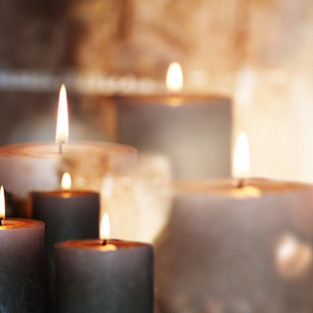Candles
- Lynne Wardach

- Jan 23, 2019
- 3 min read
It is a very common sight to see candles burning before icons in our Churches, or upon the altar during the Divine Liturgy or other services. It is thought that the practice of lighting candles at times of prayer began with the Jews. To this very day they light candles before the celebration of the Sabbath to remind them of the presence of God and that this time is set apart from everyday life. They also light memorial candles to remember the souls of their departed, as we do, in imitation of the tombs of the early Christian martyrs which were thus marked with vigil candles. We light vigil candles as a reminder to pray for our departed and keep “vigil”, watching and awaiting the day that they will be brought back to life on the day of the Lord. We offer votive lights as a way of showing our solidarity with other members of the Body of Christ for whom we are praying, offering prayers on their behalf at a time when they are in distress.
The candles that we use for such practices are not ordinary candles. They are made of beeswax, which is a natural commodity given to us, through the bees, by God. In order to make one precious pound of beeswax, it is estimated that the diligent little bee must visit 30 million separate flowers! According to St. Yves, Bishop of Chartres (1040-1116 AD) beeswax is considered a symbol of purity and therefore, beeswax in the form of a candle came to symbolize the spotless virginity of the Blessed Mother. The candle wick represents Christ’s corporal Body as it emerges from the body of the Virgin and flame, once lit, represents the soul of Christ, the light of the world, Who came forth from her. Thus, the entire candle represents the Mother and Child!
Considering of this beautiful symbolism, the Church has decided that only beeswax candles are fitting for liturgical use. It is also fitting to consider the fact that the burning of a pure beeswax candle, as opposed to other forms of wax, is much cleaner and better for God’s creation. It is the only type of candle fuel which by nature produces negatively charged ions, or particles of energy, which are released into the air around it. Because opposite electrical charges attract, these negatively charged particles attract free floating positively charged ions which are produced by pollution and are present in many airborne allergens. Once they are bound together, they are neutralized and drop to the ground where they can no longer pose a threat to our breathing space.
On February 2, the Presentation of Our Lord and His Encounter with Simeon, both Eastern and Western Churches bless candles for both home and liturgical use. Although the custom clearly originated in the west, the Slavic Churches mention the blessing of candles on this feast in our manual for liturgical services, or Trebnyk, as early as the twelfth century. Wouldn’t it be wonderful to make some of these beeswax candles for use at our home altar throughout the coming year? We can pour our beeswax into mason or other jars, or make pillars or votives according to the needs of our domestic church, and bring them with us to liturgy on the feast to be blessed. There are many kits you can purchase to make rolled beeswax candles with your children, or let them recycle and decorate some empty jars or old glassware to make votive holders for your family icon corner!
If real candles aren't exactly what your children need, be sure to check out our collection of paper candle crafts on the ByziKids page for our favorite Pinterest Printable Picks.










Comments